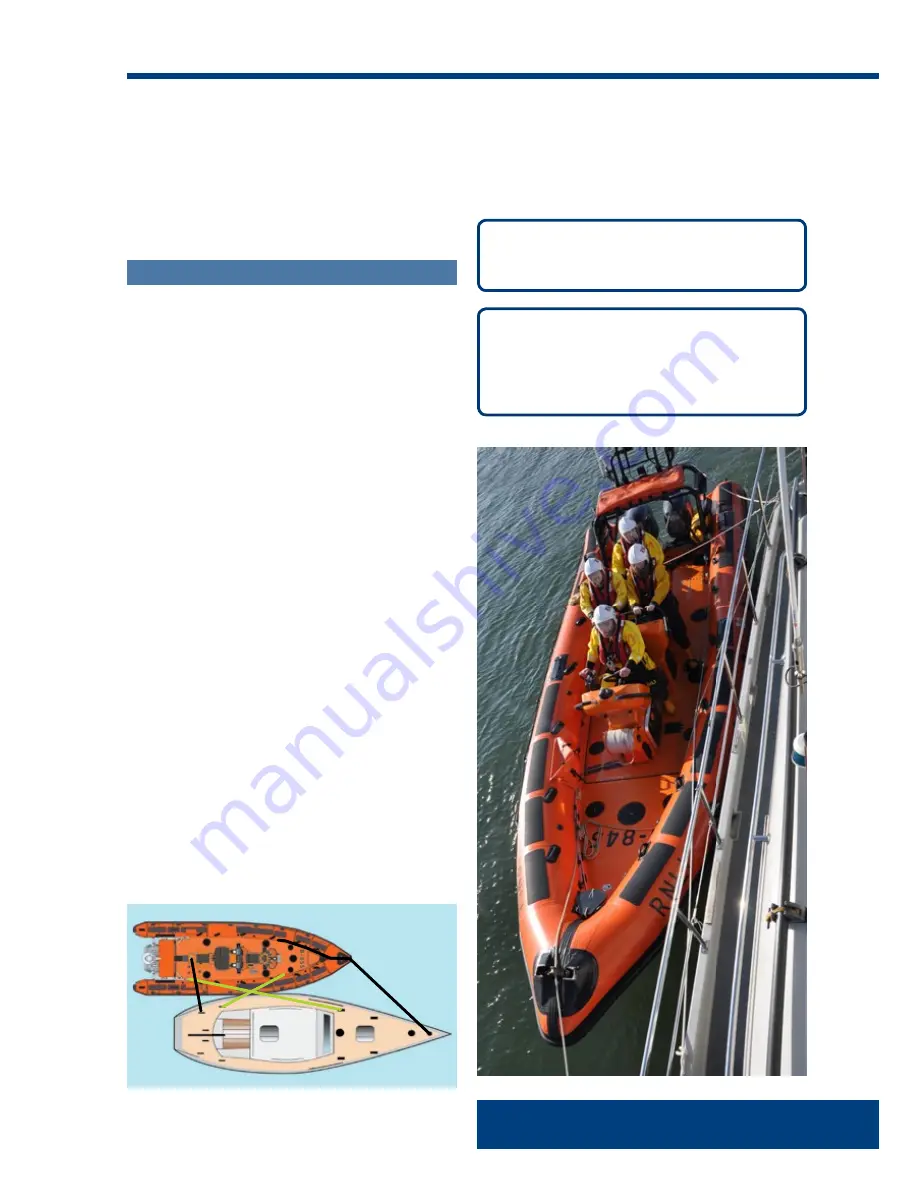
Activity 4 - SAR Unit Handling and Seamanship
47
B Class Atlantic 85 Manual – First Issue, June 2017
Activity 4 - SAR Unit Handling and Seamanship
• When increasing speed this should be done slowly until
the line is under tension.
• Once underway, monitor the tow, checking the line for
chafe and adjust inboard as necessary.
• In the event of a problem and the tow requires slipping,
simply release the line from the bollard and allow the
line to pay out. (The line is attached using a weak link so
it will part during this emergency procedure).
Alongside tow
When setting up an alongside tow two key principles apply:
The first is that the lifeboats engines must be astern of the
casualty vessel and the second is 4 lines should be used to
secure the tow (bow line, stern line, bow spring and stern
spring). There are a number of configurations of how this
can be achieved using the tow line and the two general
purpose lines on board, however as only three individual
lines are carried one of the lines will have to be used to
create two or more, for example the towline can be used
to become the bow line and the bow spring.
• Once the helm has positioned the boat appropriately
(as a guide so the stern of the casualty is in line with
the towing bollard on the Atlantic) the lines can then be
secured in the following order:
• Bow line first which will run from the casualty’s bow
to the bow of the Atlantic. The fairlead should be used
and the bow line should be secured to bow cleat on the
opposite side to the casualty vessel.
• Second is the bow spring which will run from the bow of
the Atlantic to the stern of the casualty. As the bowline
was secured on the opposite side to the casualty the same
line can now be used by leaving some slack between the
two cleats before securing on the cleat located on the
same side as the casualty (this is necessary in order to
allow adjustment to both lines).
• Once the bow line and bow spring are attached the
helm can use ahead and steer away from the casualty in
order to tension the two lines whilst the remaining lines
are attached.
• 3rd line is the stern line (a GP line can be used) which
will run from the stern of the casualty to the stern of the
Atlantic being secured on the bollard.
• 4th line is the stern spring (a GP line can be used) which
will run from the stern of the Atlantic to the bow of
the casualty being secured on the aft lifting eye using a
round turn and two half hitches.
• During the tow, the lines may need adjustment to take
up the slack.
NOTE
When towing either astern or alongside, the cleats on
the A-frame must not be used.
NOTE
Whilst preparing to board a casualty vessel, ensure
the crew member is fully briefed and takes with them
a handheld VHF and any other equipment that
may be required..
Summary of Contents for Atlantic 85
Page 1: ...B CLASS ATLANTIC 85 MANUAL...
Page 2: ......
Page 4: ......
Page 8: ......
Page 11: ...Activity 2 Personal Competencies Personal Competencies Activity 2...
Page 31: ...Activity 3 Launch and Recovery Launch and Recovery Activity 3...
Page 37: ...Activity 4 SAR Unit Handling and Seamanship SAR Unit Handling and Seamanship Activity 4...
Page 51: ...Activity 5 Search and Rescue Search and Rescue Activity 5...
Page 57: ...Activity 6 Communications Communications Activity 6...
Page 67: ...Activity 7 Navigation Navigation Activity 7...
Page 70: ......
Page 71: ...Activity 9 Propulsion and Auxiliary Systems Propulsion and Auxiliary Systems Activity 9...
Page 106: ......
















































